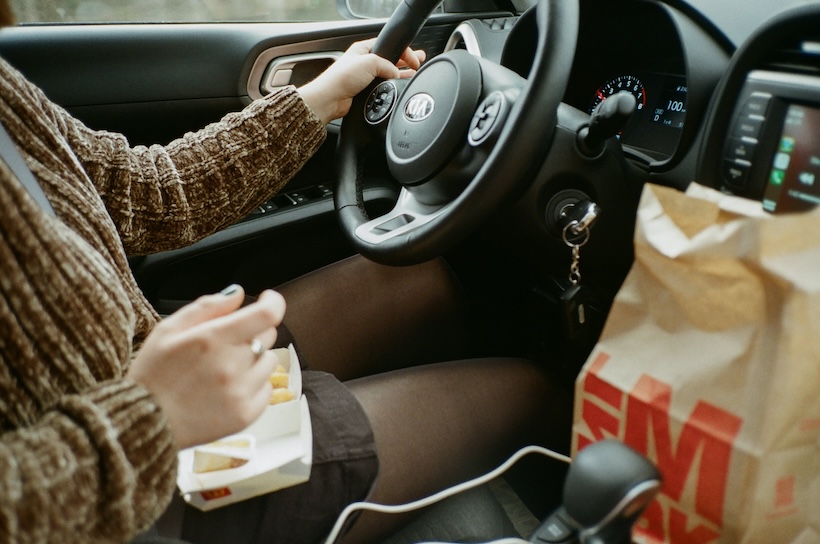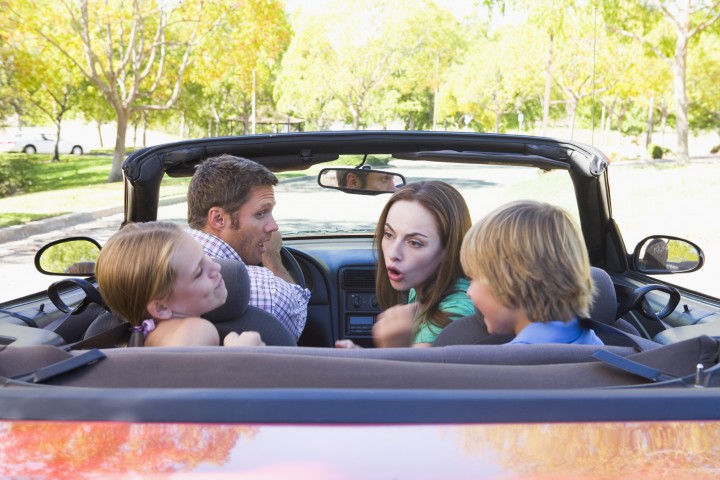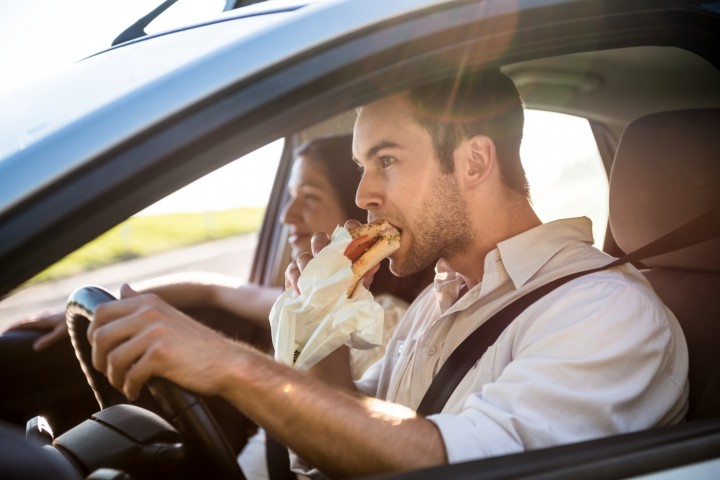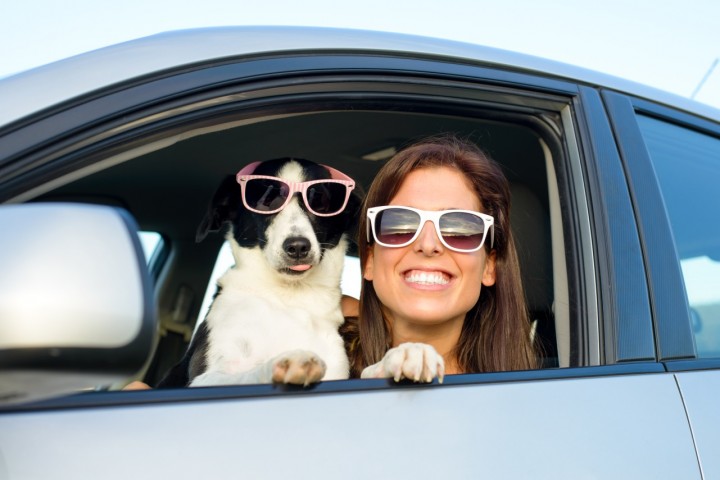WHAT IS DISTRACTED DRIVING?

Distracted driving occurs when a person’s attention is turned away from the primary task of driving. All distractions are a danger to the driver, passengers, and bystander’s safety. There are 3 main types of distractions:
1) Visual: We take our eyes off the road
2) Manual: We take our hands off the steering wheel
3) Cognitive: We let our minds wander to something other than driving
Here are some examples of distractions:
- Cell phone usage and texting
- Conversation with passengers
- Grooming
- Eating and drinking
- Reading, including maps
- Using a navigation system
- Watching a video
- Adjusting a radio or CD player
- Unrestrained pets
- Roadside pedestrians, accidents and sign twirlers
In a 2010 study, The National Highway Traffic Safety Administration reported driver distraction was the reason for 18 percent of all fatal crashes – with 3,092 people killed. Additionally, 416,000 individuals were wounded due to distractions behind the wheel.
Cell Phone Usage and Texting
While the digital age has brought technologies that keep us safer behind the wheel, the popularity of mobile devices has made distractions on the road readily available at a moment’s notice. Mobile communications has been linked to a significant increase in distracted driving, resulting in fatal crashes and debilitating injury.
Texting in particular is incredibly dangerous as it requires visual, manual and cognitive attention from the driver.
These two videos show the impact of texting on the lives of everyone in the car as well as family members:
Videos to include:
What color was the driver’s phone?
a) Black
b) Pink (correct answer)
c) White
d) Multi-colored
What did Alex tell her dad when he suggested she stop texting and driving?
a) I’m not distracted when I text and drive.
b) Dad, I can text safely.
c) That happens to other people. (correct answer)
8:00
Here are some Texting Facts:
- According to a Pew Survey, forty percent of American teens have been in a car while the driver used a mobile device in a way that put themselves and others in danger.
- According to The Virginia Tech Transportation Institute, texting while driving creates a risk of crash 23 times worse than driving without distractions.
- A staggering eleven percent of drivers aged 18-20 who survived an automobile accident admitted they were sending or receiving texts when they crashed their vehicle.
State Laws
Distracted driving not only endangers your life and property but it affects your passengers, other drivers on the road, and innocent bystanders’ safety.
There are currently no national laws on texting or using a wireless device while driving, but several states have instituted their own laws prohibiting texting or wireless phones behind the wheel. Most states require the use of hands free devices while driving.
Arizona does not currently have a statewide ban on cell phone usage but Phoenix and Tucson have a ban on texting while driving. Currently, if an accident shows that cell phone usage was the cause, a driver can be cited under reckless driving laws or be issued a moving violation “Speed not reasonable or prudent.” In the event another driver or passenger is killed, the distracted driver can be charged with involuntary manslaughter.
What You Can Do to Combat Distracted Driving
Give Clear Instructions: If there is a teenager in your life the best advice is to give teen drivers simple, clear instructions not to use their cell phones while they are on the road. Now we all know teens don’t like listening to their parents! Explain that it’s about their safety, not controlling their texting habits!
The Cellular Telecommunications Industry has coined the appropriate phrase, “On the road, off the phone”. Before a new driver hits the road, discuss the fact that taking their eyes off the road, even for a couple moments, could cost someone their lives.
Watch Distraction Videos: with your kids before they get their licenses. Let them know you will be checking their phone histories during times you know they are driving. Be accountable for checking their phone histories. It’s your teen’s life that’s at stake!
Lead by Example: Ever since they were in diapers your children have learned from your behavior. No one should text and drive. Be an example for the teens in your life. If a phone call cannot wait, pull over to a safe place.
If you’re a teen, set the example for your friends. Be clear that you won’t be a passenger in a car when the driver is using his or her cell phone.
Be the designated texter! Offer to answer the phone or text for the driver. When you’re the driver and the phone rings or you’ve received a text, verbally state you don’t want to put your friends at risk and will respond when you’ve exited the vehicle.
Stay Informed and Vigilant: Set rules for you and your family regarding distracted driving and stick to them! Tell family, friends and organizations you belong to about the dangers of distracted driving. Offer to share information with your children’s schools to help inform students, parents, and even faculty!
Conversation with Passengers

Passengers can be a helpful second pair of eyes or yet another driving distraction. Studies show that in-vehicle conversations can be as dangerous as cell phone use. While it’s difficult to eliminate conversation with passengers, minimize the distraction of conversation by following a few guidelines:
1) Don’t engage in heated, intense or angry conversations.
2) Temporarily halt conversation during difficult driving conditions.

3) Driving with children can be as dangerous as texting and driving. When you’re experiencing backseat drama, it’s best to pull over and stop the car. Teach children the importance of good behavior in the car. If the kids are old enough to understand, remind them that you want to drive safely so that they can live long, fun-filled lives!
4) New drivers should refrain from having passengers in the car other than parents or instructors for the first 6 months. It is important to focus on learning to drive and practicing defensive driving techniques until they become habit.
After 6 months, parents can begin to converse with their teen driver to assess how well they can focus on driving before introducing additional teen passengers.
Avoid Eating and Drinking

Eating and drinking is responsible for more than half of the crashes resulting from distracted driving. Hot coffee, hamburgers and burritos are 3 of the most challenging foods to eat in a vehicle while driving.
Even with a lid, hitting a bump can cause coffee to spill in our laps. Other foods not only reduce our field of vision, our hands are not free to react quickly to a sharp curve or another vehicle moving into our lane. Our reaction time is reduced. Additionally, anytime the food drops into our lap, our vision, our hand and our minds tend to focus on the problem with food in our lap. All-in-all, it’s best to eat our food at the restaurant or when we arrive home and NOT while we’re driving. Plus, can you really enjoy a tasty burger if you’re on the road?
Radio, Video and CD Players
Radios and CD players have been widely available for many years and can be a significant distraction to drivers. To minimize the threat of a crash, make adjustments only when your vehicle is stopped.
The technology in our vehicles has advanced significantly over the past few years. We can purchase vehicles with DVD players in the dashboards, mounted tablets with internet access and GPS systems. These devices add another level of distraction to our driving. Most states have laws prohibiting image display devices visible to the driver while the vehicle is in motion. Arizona’s law is as follows:
START_STATUTE28-963. Image display device; prohibition; exceptions; definition
A. A person shall not view a broadcast television image or a visual image from an image display device while that person is driving a motor vehicle and the motor vehicle is in motion on a public roadway or on an off‑highway vehicle trail as defined in section 28‑1171.
B. A person shall not operate a motor vehicle with an image display device that is visible to a driver seated in a normal driving position when the vehicle is in motion.
Restrain Your Pets

Isn’t that cute? We’ve all seen drivers with pets in their laps. Crashes involving unrestrained pets have been tallied with other distractions. Because the crash risk is high, many states have laws prohibiting driving with unrestrained pets.
How Distracting is Driving with a Pet?
In a 2011 survey conducted by AAA and Kurgo, research found that driving with man’s best friend can produce dangerous consequences.
- 65 percent of dog owners admit to petting or holding down their dog, taking photos, reaching back and other distracting activity behind the wheel.
- An unrestrained dog weighing 10-pounds can produce 500 pounds of force in a 50-mph crash
- An unrestrained 80-pound dog can generate 2,400 pounds of force in a 30-mph crash
The bottom line is that driving with pets can be dangerous for both you and furry friends. Pets are naturally distracting and if they are unrestrained they can be seriously injured or seriously injure you. If you are in an accident because your pet was distracting you, you can actually be held liable for damages.
Keep You and Your Pets Safe!
Pet restraints may seem like a hassle but they are the best way to keep you and your pets safe on the road. There are two common options for restraining your pets
- Seat Belts Restraints – Believe it or not, there are seat belts for pets. You’ll need to purchase one separately as regular seat belts can be dangerous. Seat belt restraints are relatively easy to use and often work in tandem with your normal seat belts. Restraints are sold in all different shapes and sizes to accommodate your pet’s needs.
- Pet carriers – If you have a smaller dog, a pet carrier may be a more effective method for transporting your furry friend. Look for a sturdy carrier with good ventilation and enough room for your pet to turn around and stretch out on a long drive. Be sure to secure the carrier so that it stays in place should you brake suddenly or encounter an accident.
Roadside Distractions
We need to be watching for and be aware of pedestrians, bicycles, stopped vehicles and accidents while we drive. However, we can minimize the distraction by doing the following:
1) Slow down or pull over and stop if the distraction will cause unsafe driving.
2) While it can be safer to change lanes and slow down somewhat while passing a roadside accident, refrain from the urge to see what happened. Often referred to as “gawkers”, drivers who slow down out of curiosity are more likely to cause an accident themselves.
3) Sign spinners are becoming more popular at intersections to advertise local businesses. Refrain from being distracted by them when your vehicle is in motion. Some municipalities have banned sign spinning but Arizona currently does not have a statute.
When we’re behind the wheel, we are faced with uncontrollable and controllable circumstances. Most distractions are controllable and can be eliminated altogether. It’s just a decision.
Distracted driving is a deadly behavior. PLEASE, pay attention to your driving!